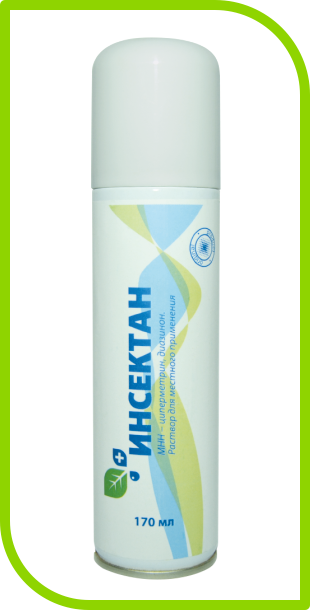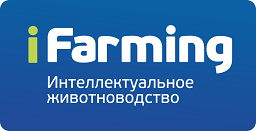
INSTRUCTION
of using Insectan against ectoparasites of dogs and cats, zoophilic flies, midges, gnats, and gadflies, cockroaches, slimy, puffer and vermiformes in livestock, poultry housing and in the environment.
(Organization – developer: “BioChimPharm”, Raduzhny, Vladimir region).
I. GENERAL PROVISIONS
1. Trade name of the preparation: Insectan.
International nonproprietary name: permethrin, dibrom.
2. Dosage form: As active ingredients, Insectane contains permethrin, dibromo, and also a solvent.
The drug is a homogeneous oily liquid from light yellow to dark brown with a weak specific odor.
Insectane is produced in packs of 170 g aerosol cans and 1, 3, 5, 10 and 30 ml vials. Other packing, agreed in the prescribed manner, is allowed.
3. Each package is marked with the manufacturer’s name, address and trademark, the name of the preparation, the contents of the active substances, the serial number, the date of manufacture and the expiration date (month, year), storage conditions, cylinder volume, “animals” , “Shake before use,” designations of technical specifications and provide guidance on the use.
Shelf life of the drug under the conditions of storage is 1.5 years from the date of manufacture.
4. Store the preparation in the manufacturer’s packaging, in a dry, dark place at a temperature from minus 25 ° С to 20 ° С, far from heating devices.
II. PHARMACOLOGICAL PROPERTIES
5.Insectan has a pronounced insecto-acaricidal effect, is active against flies, cockroaches, midges, slugs, scabies, lice, fleas, withers, puffers, gnats and gadflies.
6. The drug is medium-toxic for warm-blooded animals (hazard class III according to GOST 12.1.007-76), in recommended doses and concentrations does not have a local irritant and allergenic effect. Dangerous for bees and fish.
III. APPLICATION PROCEDURE
7. Insectans are used to control the ectoparasites of animals, as well as cockroaches, flies, sluts and gnats in livestock, poultry and other auxiliary premises and in the external environment.
Against flies, midges, slimy, cockroaches, puffers and withers:
In order to destroy flies or midges in the premises for keeping animals and poultry, the drug is applied by the method of small-drop spraying, applying the drug selectively on the surface, especially to the places of “incubation” of insects. The treatment is carried out with the help of any kind of sprayer or plant (DUK, SAG, etc.). The consumption of the drug during spraying is 2-5 ml / m², and in aerosol treatment – 1 ml / m3, exposure – 30 minutes.
8. Pest control with poultry keeping in cages or on the floor is carried out without disrupting the production process, in the presence of a bird.
Processing is subjected to no more than 2/3 of the total surface of the room (walls, ceilings, pillars, dredged trenches under cell batteries, floor, lampshades). Before the spraying, the eggs are collected. The bird and equipment (cages, nests, feeding troughs, drinking bowls) are not treated with the drug.
The consumption of the drug in the aerosol treatment is 1 ml / m3.
Disinfestation of poultry houses in the presence of poultry is carried out with operating ventilation, open doors. The supply ventilation is switched off for the treatment period (30-40 minutes). Working personnel is admitted to the premises 40 minutes after treatment.
9. Disinsection of premises containing dairy cattle is carried out in the absence of animals, the room is closed, ventilation is turned off, the remains of fodder, manure and other substrates being a place of mass congestion and fl ood of flies and other insects are cleaned.
Treat the surface of walls, ceilings, floors and equipment, avoiding the ingress of insecticidal liquid in the feeders and drinkers. The placement of the milk receiver and the dairy equipment are not treated with Insectane.
Repeated treatment is carried out after 12-14 days, then – by entomological indications, with an interval of 2-3 weeks.
10. After pest control, the premises are ventilated, drinking bowls and feeders are rinsed with water and after 1-1.5 hours animals are placed in them.
11. If it is not possible to remove animals (calves, pigs, etc.) from the premises, the latter is treated in the presence of animals, except for dairy cattle.
In these cases, windows and doors are opened for the period of disinsection of the room and its subsequent airing.
Places of mass congestion and the breeding of insects (flies, midges, cockroaches and slugs) outside the premises and other livestock and poultry facilities are sprayed with the drug at the rate of 10 ml / m². Repeated treatments are carried out with an interval of 7-10 days.
Against lice, fleas, withers, with demodectic and noctoedrosis in dogs and cats:
12. Carry out aerosol treatment in enclosed spaces. The drug is applied to the skin-hair cover from a distance of 15-20 cm evenly over the entire surface of the animal’s body.
You can apply the drug with a tampon or comb with cotton wool soaked in insectane at a rate of 0.5 ml per 100 cm² of the body surface. At the same time, the strips are first run along the spine from the head to the tail, then along the sides and the white line of the abdomen, after which the head, neck, shoulder blades and tail are treated. The interval between the bands makes 2-3 cm. The treatment is carried out 2-3 times with an interval of 10-14 days.
Destruction of fleas in the premises where the dogs are kept is carried out by 2-3-fold spraying with the drug at intervals of 10-14 days. The drug consumption is 5 ml per 1 m2. Remains of the drug are removed from the surface of the room with water (wet method).
13. The treatment of animals from the dropper bottle is carried out as follows: spreading the wool, the drug is applied to the skin in the back area, between the shoulder blades, at the neck and at the base of the head in the following doses (ml per animal): dogs weighing from 2 to 10 kg – 1.4 ml, from 10 to 20 kg – 2.8 ml, over 20 kg – 4.2 – 5.6 ml; cats weighing up to 1 kg – 0.3 ml, 1 – 3 kg – 0.6 ml, 3 kg or more – 1 ml. Repeated treatments are performed according to indications, but not more often than 1 time per month.
To eradicate ixodid ticks on the animal’s body, a drug in the amount of 1 drop is applied to a tick (the place of its attachment to the skin) and held for 20 to 30 minutes. If the tick does not move away, then it is extracted with tweezers and destroyed.
Against the ear scars in different species of animals:
The drug from the aerosol canister is injected into each ear shell within 2 seconds from a distance of 15-20 cm, directing the torch to the inner surface of the auricles. The drug can be applied with a swab at the rate of 0.5 ml per treatment of a single ear, rubbing with light circular motions for 3-5 seconds. The treatment is carried out 3-4 times with an interval of 5-7 days.
The treatment of dogs and cats can be carried out by instilling the drug in the ears of animals.
Before processing, the auricles are cleaned of crusts, scabs with a tampon moistened with the drug, and then instilled Insectane 3-5 drops into each ear. Cats and small dogs – 3 drops, medium dogs – 4 drops and large dogs – 5 drops. In order to achieve a more complete treatment, the auricle is folded in half and slightly massaged by its base. Drops must be made in both ears, regardless of their lesion.
14. Slaughter of animals for meat is allowed not earlier than 10 days after the last treatment with insectane. When forced to slaughter a predetermined period, meat is used for animal feed, or for the production of meat and bone meal.
IV. PRECAUTIONARY MEASURES
15. When working with the drug must comply with the “Sanitary rules for the storage, transportation and use of pesticides (pesticides) in agriculture (№1123-73 dated 20.09.73).
16. Everyone working with the drug should be provided with and must use a set of overalls and personal protective equipment (robe, headdress, apron rubberized, rubber boots, anti-dust protective goggles, respirators F-62 Sh (SHM), U-2K Astra- 2 “type, such as” Petal-40 “and” Petal-5 “, or gas mask A)
17. To provide first-aid first aid in places of work with the drug, there must be first-aid kits that are replenished as they are spent.
18. Do not eat, drink or smoke while working. Duration of work with the drug should not exceed 6 hours per day.
19. After work, work clothes should be removed, wash your face and hands with warm water and soap, rinse your mouth with water.
20. If the product gets on the skin or mucous membranes, it is thoroughly rinsed with a water jet or carefully removed with a swab and then washed with water or a slightly alkaline solution,
If the drug has entered the body through the mouth, the victim should be given several glasses of warm water and irritation of the root of the tongue cause vomiting. After that, the dates drink 0.5 glasses of water with activated carbon tablets or another absorbent, and then a salt laxative.
If the worker has symptoms of poisoning (dizziness, general weakness, nausea), it is necessary to stop work, remove work clothes, wash your face and hands and contact medical personnel.
In case of accidental poisoning by the drug, an intramuscular injection of 1% solution of calcium chloride at a dose of 0.5 mg / kg of body weight, 1-2 times a day, for 2-3 days and 40% glucose solution at a dose of 1 ml / kg of body weight).








